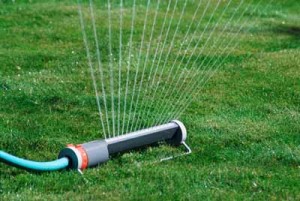Raised plant bed irrigation system
For raised plant beds, the soaker hose irrigation system is the most effective. It doesn’t waste water like other irrigation systems do. A raised plant bed requires more care and maintenance.
Start off by filling a 5 gallon water bucket for one minute. Measure how much water has filled the bucket in this time and multiply it by 60. This will represent the number of gallons per hour that are delivered. If this number is above 30, install a pressure regulator to the system.
Measure the raised bed to determine how much length of soaker hose you need. Double the amount and you will get the length of the soaker hose. The hose will need to be positioned in a U shape. Nail down a couple of small nails each 6 inches along the top of the raised bed. Position the hose between the nails and screw the end cap on the hose.
Cut the hose and inset T joints in the holes in two places. Mount a metal hose clamp on each joint. Place the hose in a U shape across the raised bed. The hose ends should reach the T joints. Attach the metal hose clamps to the ends of the soaker hose and then connect the hose to the open T joints. Secure the hose in place using metal hose clamps. Hold the hose with U shaped stakes made of wire hangers. Place several of these pieces along the length of the hose. Turn the water on at one quarter the power of the system. Inspect if the system is working properly. As a last step, cover the hose with a light layer of mulch.

 Gardens, lawns and plants in general require a proper amount of water to thrive. The sprinkler s...
Gardens, lawns and plants in general require a proper amount of water to thrive. The sprinkler s... There are many advantages in growing a grapes in your backyard. There are many factors you need ...
There are many advantages in growing a grapes in your backyard. There are many factors you need ... A very efficient irrigation system, is the drip irrigation system. It uses a drip tube to delive...
A very efficient irrigation system, is the drip irrigation system. It uses a drip tube to delive... Container garden irrigation systems make watering a simple task. It is crucial that the system w...
Container garden irrigation systems make watering a simple task. It is crucial that the system w... The drip irrigation system is an efficient way of watering your plants reducing water waste and ...
The drip irrigation system is an efficient way of watering your plants reducing water waste and ... Although costlier than common sprinkler system, the drip irrigation system is the most efficient...
Although costlier than common sprinkler system, the drip irrigation system is the most efficient... The drip irrigation system is an effective and automatic irrigation system that delivers a prope...
The drip irrigation system is an effective and automatic irrigation system that delivers a prope... Proper lawn watering techniques and knowing when and how much to water will assure a healthy, ae...
Proper lawn watering techniques and knowing when and how much to water will assure a healthy, ae...














